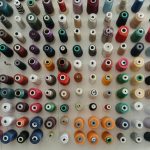When it comes to screen printing, choosing the right screen material is like selecting the perfect tool for a craftsperson. Each material has its own unique properties that can make a significant impact on the quality of your prints.
Understanding the intricacies of mesh count, fabric characteristics, and filament types is essential for mastering the art of screen printing. In this guide, you'll explore the nuances of polyester, nylon, and stainless steel screen materials, and learn how to make informed decisions based on your specific project requirements.
Get ready to elevate your screen printing game by selecting the best screen material for your needs.
Key Takeaways
- Mesh count is crucial for achieving desired results in screen printing, with higher mesh counts being ideal for intricate designs and finer details.
- Polyester mesh offers unmatched durability and quality for screen printing, with excellent ink adhesion and vibrant prints.
- Nylon mesh is resistant to chemicals and abrasion, making it suitable for long-term use, and proper tensioning techniques are crucial for high-quality prints.
- Monofilament screens have advantages in terms of durability and consistency, maintaining tension for precise prints, while multifilament screens offer superior ink adhesion and better control over ink deposition.
Understanding Mesh Count
When screen printing, you should print your design through a screen mesh using a higher mesh count for finer details and a lower mesh count for bolder designs. Understanding mesh count accuracy is crucial for achieving the desired results in screen printing.
A higher mesh count, such as 230-305, is ideal for intricate designs as it allows for more precise ink placement, resulting in finer details. On the other hand, a lower mesh count, around 110-156, is more suitable for designs that require higher ink coverage, such as bold graphics or text. This understanding of mesh count enables you to choose the appropriate screen for your specific design, ensuring accuracy and efficiency in ink coverage.
Additionally, when considering mesh count accuracy, it's essential to factor in ink coverage efficiency. Higher mesh counts require less ink to achieve the desired effect due to their finer screen openings, while lower mesh counts necessitate more ink for proper coverage. By optimizing the mesh count based on the design requirements, you can efficiently manage ink usage, resulting in cost-effective and high-quality prints.
Mastering mesh count selection empowers you to execute precise and efficient screen printing, achieving optimal results for different design intricacies and ink coverage needs.
Silk Screen Fabric Characteristics
To achieve optimal results in screen printing, select a silk screen fabric with the appropriate mesh count based on your design requirements and ink coverage needs. The characteristics of silk screen fabric, such as tension and ink adhesion, play a crucial role in the quality of your prints. Understanding these characteristics will help you make informed decisions when choosing the right fabric for your screen printing projects.
| Silk Screen Fabric Characteristic | Description |
|---|---|
| Tension | Proper tension ensures even ink deposit and prevents ink seepage. High tension fabrics offer better detail reproduction. |
| Ink Adhesion | The fabric's ability to hold ink and release it onto the substrate. Proper adhesion ensures sharp and consistent prints. |
When selecting silk screen fabric, consider the tension level for precise prints and the ink adhesion for vibrant and durable results. Understanding these characteristics will enable you to choose the ideal fabric that aligns with your specific printing needs. By leveraging the right silk screen fabric, you can enhance the overall quality and visual impact of your screen printing projects.
Polyester Mesh Pros and Cons
When it comes to polyester mesh for screen printing, you'll find that its durability and quality are unmatched, making it a top choice for many printers.
The mesh size plays a crucial role in determining the intricate details and resolution of your prints, allowing for high-quality output.
However, it's important to consider the potential cons of polyester, such as static buildup and limited solvent resistance, before making your final decision.
Polyester Durability and Quality
Your understanding of polyester mesh's durability and quality is crucial for achieving successful screen printing results.
Polyester mesh is favored for its strength, which allows it to withstand the rigors of screen printing, ensuring longevity and consistency in print quality. Its durability also promotes stable tension, crucial for maintaining the accuracy of the printed image.
Additionally, polyester mesh facilitates excellent ink adhesion, ensuring that the ink adheres uniformly to the printing surface, resulting in sharp and vibrant prints.
However, it's important to note that polyester mesh may have limitations when it comes to solvent-based inks and certain chemicals, which can affect its durability and quality over time.
Understanding these nuances will help you make informed decisions when choosing polyester mesh for your screen printing needs.
Mesh Size and Printing
Polyester mesh offers both advantages and disadvantages in screen printing, based on its mesh size and printing capabilities. When considering mesh size and printing with polyester mesh, it's important to understand the following:
- Mesh Tension: Polyester mesh tends to hold tension well, allowing for more consistent printing results.
- Ink Adhesion: The smooth surface of polyester mesh can sometimes lead to challenges with ink adhesion, especially with certain types of inks.
- Mesh Size: Polyester mesh comes in various mesh counts, offering versatility for different types of designs and printing needs.
- Durability: Polyester mesh is more susceptible to breakdown from exposure to certain chemicals, impacting its lifespan in comparison to other mesh materials.
Understanding these aspects of polyester mesh can help you make informed decisions when selecting screen materials for your printing projects.
Cons of Polyester
Considering the cons of polyester mesh in screen printing, it's important to be aware of its limitations while evaluating its suitability for your specific printing needs.
Polyester mesh has some drawbacks that you should take into account. Polyester ink adhesion can be a concern with this material, as it may not bond as effectively as with other mesh types, impacting the overall quality and durability of the print.
Additionally, while polyester mesh is known for its stretchability, this characteristic can also be a disadvantage. Over time, the mesh may lose tension, affecting the accuracy and consistency of the prints.
It's crucial to consider these limitations and balance them against the benefits when deciding whether polyester mesh is the right choice for your screen printing projects.
Nylon Mesh for Screen Printing
When choosing screen material for screen printing, nylon mesh offers durability and versatility, making it a popular choice among printers. Nylon mesh benefits include its resistance to chemicals and abrasion, making it suitable for long-term use. Additionally, its low moisture absorption ensures dimensional stability, crucial for maintaining accurate designs.
Proper mesh tensioning techniques are essential for achieving high-quality prints. Tension meters can be used to measure and adjust the tension, ensuring uniformity across the entire screen. It's important to stretch the mesh evenly and avoid over-tensioning, which can lead to premature mesh failure. Using high-quality stretching equipment and following precise tensioning processes is crucial for optimal results.
When working with nylon mesh, it's also important to consider the mesh count, as it determines the level of detail that can be achieved in the prints. Understanding these aspects of nylon mesh and implementing appropriate tensioning techniques will contribute to achieving exceptional results in screen printing.
Stainless Steel Screen Material
If you want a screen material that offers exceptional durability and longevity for screen printing, stainless steel mesh is a top choice. Stainless steel screens are known for their remarkable durability, making them a popular choice for high-volume production runs and extended use. The material's resistance to corrosion and wear ensures that the screens maintain their integrity over time, providing consistent and reliable performance.
Stainless steel mesh is also highly compatible with various types of inks, including solvent-based and UV-curable inks. This compatibility makes it a versatile option for a wide range of printing applications, from textiles and apparel to electronics and industrial products. The material's smooth surface allows for precise ink deposition, resulting in sharp and detailed prints.
Additionally, stainless steel screens are capable of achieving fine mesh counts, making them suitable for intricate designs and high-resolution prints. This capability ensures that even the most intricate details are accurately reproduced, meeting the demands of the most discerning clients.
Comparing Monofilament Vs. Multifilament
When choosing between monofilament and multifilament screen materials, consider the durability advantages of monofilament and the ink control benefits of multifilament.
You'll find that monofilament screens are known for their strength and resistance to abrasion, making them a great choice for long-term use.
On the other hand, multifilament screens offer finer mesh counts, which allow for better ink control and finer detail in your prints.
Monofilament Durability Advantages
For durable screen printing, monofilament offers clear advantages over multifilament due to its superior strength and longevity. When considering monofilament durability advantages, it's essential to understand the following:
- Enhanced Mesh Tension: Monofilament screens maintain consistent tension over a longer period, ensuring precise and detailed prints.
- Improved Ink Adhesion: The single-strand construction of monofilament meshes provides a smoother surface, promoting better ink adhesion and preventing smudging or blurring.
- Resistance to Abrasion: Monofilament screens are more resistant to abrasion, resulting in prolonged use without compromising print quality.
- Longevity and Cost-Effectiveness: Due to its durable nature, monofilament screens have a longer lifespan, making them a cost-effective choice for high-volume printing.
Understanding these advantages will enable you to make informed decisions when selecting screen materials for your printing needs.
Multifilament Ink Control Benefits
To achieve precise ink control and detailed prints, you'll benefit from understanding the differences in ink behavior between monofilament and multifilament screen materials.
Multifilament screens offer superior ink adhesion due to their finer mesh, which allows for better color vibrancy and detail in prints. The multiple filaments in multifilament screens provide more surface area for the ink to adhere to, resulting in sharper and more vibrant colors compared to monofilament screens.
Additionally, multifilament screens enable better control over ink deposition, leading to improved color accuracy and consistency in the printing process.
Understanding these differences will allow you to harness the full potential of multifilament screen materials for achieving high-quality, detailed prints with precise ink control.
Choosing the Right Screen Material for Your Project
To achieve the best results in your screen printing project, you need to select the right screen material. The screen material you choose plays a crucial role in determining the quality of your prints. Here are some key factors to consider when choosing the right screen material for your project:
- Mesh Count: The mesh count of the screen material determines the level of detail and clarity in your prints. Higher mesh counts are suitable for fine details, while lower mesh counts are ideal for bold designs with heavy ink coverage.
- Material Tensile Strength: The tensile strength of the screen material is essential for maintaining proper tension during the printing process. Look for materials that offer excellent tension control to ensure consistent and precise prints.
- Ink Adhesion: Consider the compatibility of the screen material with different types of inks. Some materials may offer better adhesion for specific ink formulations, ensuring vibrant and long-lasting prints.
- Durability and Reusability: Choose a screen material that's durable and can withstand multiple printing cycles without deteriorating. This ensures cost-effectiveness and consistent print quality over time.
Selecting the right screen material based on these factors will contribute to the overall success of your screen printing project.
Frequently Asked Questions
Can Screen Printing Be Done on Materials Other Than Fabric, Such as Metal or Plastic?
Yes, screen printing can be done on materials other than fabric. Metal printing and plastic surfaces are commonly used. The process involves creating a stencil on a mesh screen and then transferring ink onto the desired material.
Are There Any Eco-Friendly or Sustainable Options for Screen Printing Materials?
When it comes to screen printing, you can explore eco-friendly options and sustainable alternatives for materials. Consider using recycled fabrics or water-based inks to reduce environmental impact and create more sustainable products.
What Are the Best Practices for Cleaning and Maintaining Different Types of Screen Printing Materials?
To effectively maintain your screen printing materials, utilize proper cleaning techniques and establish a regular maintenance schedule. This will ensure longevity and optimal performance, allowing you to produce high-quality prints consistently.
How Does the Thickness or Weight of the Screen Material Affect the Final Print Quality?
When it comes to screen printing, the thickness or weight of the screen material impacts mesh tension, ink coverage, image resolution, and color accuracy. The right balance ensures optimal print quality and vibrant results.
Are There Any Special Considerations or Techniques for Printing on Dark or Colored Fabrics With Different Screen Materials?
When printing on dark fabrics, different screen materials require special techniques. For example, with finer mesh screens, use a thicker ink deposit to ensure opacity on colored fabrics. Experiment with various screen materials and ink types for best results.
- Tetron Fabric for Marine Applications: Durability and Use Cases - June 18, 2025
- Tetron Fabric for Outdoor Furniture: Weather Resistance and Care - June 18, 2025
- Tetron Fabric for Wall Coverings: Style and Application Tips - June 18, 2025







